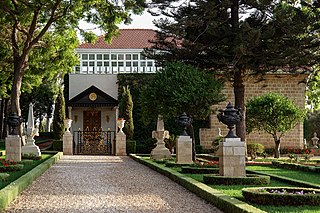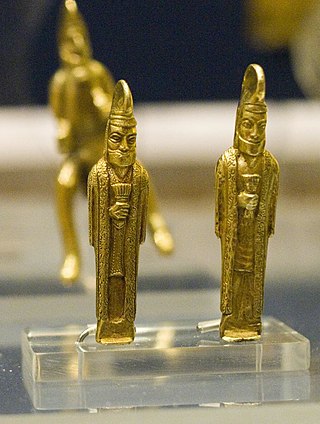
The Baháʼí Faith is a monotheistic religion founded in the 19th century that teaches the essential worth of all religions and the unity of all people. Established by Baháʼu'lláh, it initially developed in Iran and parts of the Middle East, where it has faced ongoing persecution since its inception. The religion is estimated to have approximately 9 million adherents as of 2020, spread throughout most of the world's countries and territories.

Zoroastrianism, also called Mazdayasnā or Beh-dīn (بهدین), is an Iranian religion centred on the Avesta and the teachings of Zarathushtra Spitama, who is more commonly referred to by the name Zoroaster. Among the world's oldest organized faiths, its adherents exalt an uncreated, benevolent, and all-wise deity known as Ahura Mazda, who is hailed as the supreme being of the universe. Opposed to Ahura Mazda is Angra Mainyu (𐬀𐬢𐬭𐬀⸱𐬨𐬀𐬌𐬥𐬌𐬌𐬎), who is personified as a destructive spirit and the adversary of all things that are good. As such, the Zoroastrian religion combines a dualistic cosmology of good and evil with an eschatological outlook predicting the ultimate triumph of Ahura Mazda over evil. Opinions vary among scholars as to whether Zoroastrianism is monotheistic, polytheistic, henotheistic, or a combination of all three. Zoroastrianism shaped Iranian culture and history, while scholars differ on whether it significantly influenced ancient Western philosophy and the Abrahamic religions, or gradually reconciled with other religions and traditions, such as Christianity and Islam.

The Parsis or Parsees are a Zoroastrian community in the Indian subcontinent. They are descended from Persian refugees who migrated to the Indian subcontinent during and after the Arab-Islamic conquest of Iran in the 7th century, when Zoroastrians were persecuted by the early Muslims. Representing the elder of the Indian subcontinent's two Zoroastrian communities, the Parsi people are culturally, linguistically, and socially distinct from the Iranis, whose Zoroastrian ancestors migrated to British-ruled India from Qajar-era Iran. The word Parsi is derived from the Persian language, and literally translates to Persian.

The Baháʼí Faith is an independent world religion that originated in Iran in the 19th century, with an emphasis on the spiritual unity of mankind. Although it came from Islamic roots, its teachings on the unity of religion and its acknowledgement of Krishna as a divine Manifestation of God have created a bridge between religious traditions that is accepting of Hinduism.

Sexual orientation in Zoroastrianism is, as in many other religions, a controversial topic with differing consensus over time.

The Federation of Zoroastrian Associations of North America (FEZANA) is an umbrella organization that represents and unites the Zoroastrian associations in North America. Founded in 1987, its primary goals include promoting the study and understanding of the Zoroastrian religion, culture, and history, as well as facilitating communication and collaboration among its member associations. FEZANA also works to support charitable activities and community development projects within the Zoroastrian community and beyond.
Asia is the largest and most populous continent and the birthplace of many religions including Buddhism, Christianity, Confucianism, Hinduism, Islam, Jainism, Judaism, Shinto, Sikhism, Taoism, Korean shamanism, and Zoroastrianism. All major religious traditions are practiced in the region and new forms are constantly emerging. Asia is noted for its diversity of culture. Hinduism and Islam are the largest religion in Asia with approximately 1.2-1.3 billion adherents each.

Religion in Iraq dates back to Ancient Mesopotamia, particularly Sumer, Akkad, Assyria and Babylonia between circa 3500 BC and 400 AD, after which they largely gave way to Judaism, followed by Syriac Christianity and later to Islam. Iraq consists of a multi-ethnic, multi-religious and multi-sectarian population, all living together in one geographical area. The Iraqi civilization was built by peoples and nations, including the Sumerians, Akkadians, Assyrians, Persians, Turks, Arabs, and Babylonians. Religious and cultural circumstances have helped Arabs to become the majority of Iraq’s population today, followed by Kurds, Turkmen, and other nationalities.
Growth of religion involves the spread of individual religions and the increase in the numbers of religious adherents around the world. In sociology, desecularization is the proliferation or growth of religion, most commonly after a period of previous secularization. Statistics commonly measure the absolute number of adherents, the percentage of the absolute growth per-year, and the growth of converts in the world.

A mobed, mowbed, or mobad is a Zoroastrian cleric of a particular rank. Unlike a herbad (ervad), a mobed is qualified to serve as celebrant priest at the Yasna ceremony and other higher liturgical ceremonies. A mobed is also qualified to train other priests.

Sunni Islam (Hanafi/Deobandi) is the largest and the state religion of the Islamic Emirate of Afghanistan. According to The World Factbook, Sunni Muslims constitute between 84.7 and 89.7% of the population, and Shia Muslims between 10 and 15%. Other religions are followed by 0.3% of the population.

The persecution of Zoroastrians has been recorded throughout the history of Zoroastrianism, an Iranian religion. The notably large-scale persecution of Zoroastrians began after the rise of Islam in the 7th century CE; both during and after the conquest of Persia by Arab Muslims, discrimination and harassment against Zoroastrians took place in the form of forced conversions and sparse violence. Muslims who arrived in the region after its annexation by the Rashidun Caliphate are recorded to have destroyed Zoroastrian temples. Zoroastrians living in areas that had fallen under Muslim control were required to pay a tax known as jizya.
For approximately a millennium, the Abrahamic religions have been predominant throughout all of the Middle East. The Abrahamic tradition itself and the three best-known Abrahamic religions originate from the Middle East: Judaism and Christianity emerged in the Levant in the 6th century BCE and the 1st century CE, respectively, while Islam emerged in Arabia in the 7th century CE.
Religion in Iran has been shaped by multiple religions and sects over the course of the country's history. Zoroastrianism was the main followed religion during the Achaemenid Empire, Parthian Empire, and Sasanian Empire. Another Iranian religion known as Manichaeanism was present in Iran during this period. Jewish and Christian communities thrived, especially in the territories of northwestern, western, and southern Iran—mainly Caucasian Albania, Asoristan, Persian Armenia, and Caucasian Iberia. A significant number of Iranian peoples also adhered to Buddhism in what was then eastern Iran, such as the regions of Bactria and Sogdia.

As of the 2020 United States census, Arizona had a population of 7,151,502.

The main religions that exist or historically existed in Kurdistan are as follows: Sunni Islam & Shia Islam. Overall today, Sunni Islam is the most adhered to religion in Kurdistan.
Irreligion in Iran has a long historical background, but is difficult to measure, as those who profess atheism are at risk of arbitrary detention, torture, and the death penalty. Non-religious citizens are officially unrecognized by the Iranian government. In the official 2011 census, 265,899 persons did not state any religion. Between 2017 and 2022, the World Values Survey found that 1.3% of Iranians identified as atheists, and a further 14.3% as not religious. In the 1999-2004 cycle, the WVS had found 1% identified as atheist and 3% as not religious.

Zoroastrianism, an Iranian religion, has been present in India for thousands of years. Though it split into a separate branch, it shares a common origin with Hinduism and other Indian religions, having been derived from the Indo-Iranian religion. Though it was once the majority and official religion of the Iranian nation, Zoroastrianism eventually shifted to the Indian subcontinent in light of the Muslim conquest of Iran, which saw the Rashidun Caliphate annex the Sasanian Empire by 651 CE. Owing to the persecution of Zoroastrians in the post-Sasanian period, a large wave of Iranian migrants fled to India, where they became known as the Parsi people, who now represent India's oldest Zoroastrian community. Later waves of Zoroastrian immigration to India took place over the following centuries, with a spike in the number of these refugees occurring during the Safavid conversion of Iran to Shia Islam and again during the reign of the Qajar dynasty, whose persecution of Zoroastrians prompted many to flee to British India, where they became known as the Irani people. Though Zoroastrian, the Parsis and the Iranis are culturally, linguistically, and socially distinct from each other due to their inception in separate periods of migration.
Throughout its history the city of Houston, Texas has been religiously influenced by Protestant Christianity in the Bible Belt. Since the latter half of the 20th century, the Houston area has become home to many different religions in part to its large ethnic diversity, immigration, and refugee resettlement.











